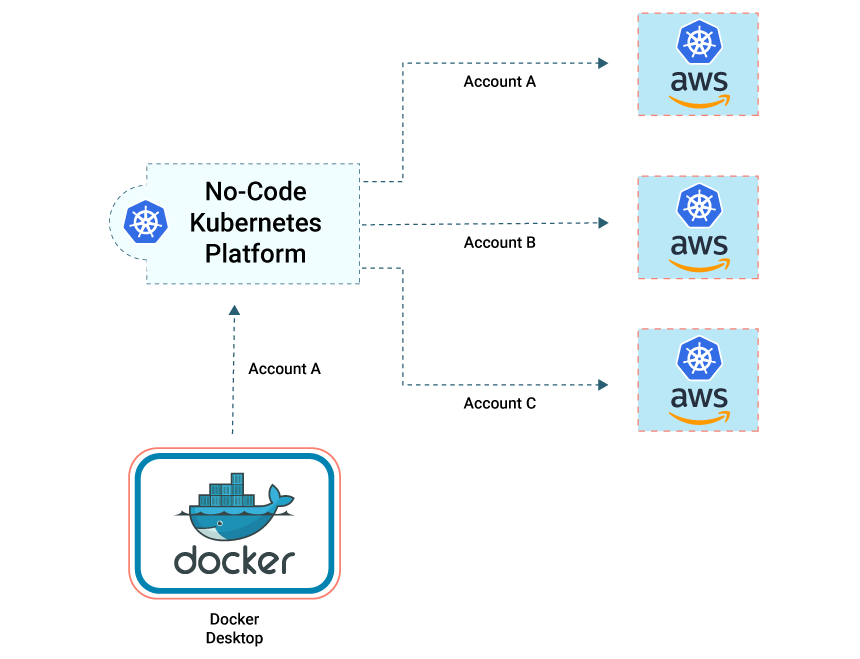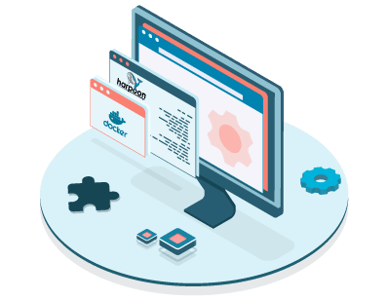
Are you tired of managing Kubernetes resources through complex configuration processes? Look no further than No-Code Kubernetes with Harpoon Docker Extension. With No-Code Kubernetes, you can simplify your Kubernetes resource management with features such as declarative configuration, self-healing, and service discovery. The Harpoon Docker Extension further simplifies the process with a no-code interface, custom software integration, and third-party integration capabilities. In this expert series, we will dive into the benefits of No-Code Kubernetes and the Harpoon Docker Extension, offering guidance on effectively managing Kubernetes clusters with Harpoon.
What Is No-Code Kubernetes?
Kubernetes is an orchestration tool that provides a managed execution environment for deploying, running, managing, and orchestrating containers across clusters. No-Code Kubernetes refers to the use of visual interfaces and drag-and-drop tools to deploy and manage Kubernetes clusters and applications without writing any code.

The advantage of using No-Code Kubernetes is that developers and DevOps teams can effortlessly handle Kubernetes resources like pods, services, and deployments without requiring advanced coding expertise. No-Code Kubernetes platforms also offer features such as automatic scaling, monitoring, and logging, making it easier for teams to manage their applications in a Kubernetes environment.
What Is the Harpoon Docker Extension?
Developing a microservices application involves utilizing numerous tools, and when these tools are decentralized, it becomes even more challenging to install, manage, and utilize them. That's where Docker Extensions come in. Docker Extensions are third-party tools to extend Docker's functionality. The Docker Extension that is used for the No-Code Kubernetes is the Harpoon Docker Extension.
With the use of No-Code, Harpoon can make a production environment ready with built-in security in very little time. Harpoon enables users to easily deploy software by providing a simple search, drag and drop, and the software will be running in seconds. It has integration with GitHub to build and deploy custom software.

Kubernetes Cluster Deployment and Management Using Harpoon
The below diagram shows how No-Code Kubernetes works with Harpoon:

The high-level phases in Harpoon include:
- Starting a Cluster: Once Harpoon is enabled as a Docker Extension, it will require access to the corresponding cloud service provider account. Using Harpoon we can quickly construct a cluster that will be operational in a matter of seconds.
- Tearing Down a Cluster: The clusters can be easily terminated, and the corresponding infrastructure will be automatically torn down.
- Scaling up a Cluster: Simply dragging another node element will scale up an already running cluster. When the cluster is scaled up, the Harpoon will indicate it.
- Scaling Down a Cluster: By removing the node element, the cluster can be downsized. The initial node that was automatically setup, cannot be removed.
- Deploying Containers: Harpoon will automatically search for a Dockerfile and construct a container image. Then the application can be deployed with just one click.
Best Practices To Use Harpoon for No-Code Kubernetes
Here are some of the best practices for deploying No-code Kubernetes:
- Make sure the Container Image is validated before dragging it from Docker Hub
- When linking the cloud provider, make sure to grant the necessary roles and permission to the IAM user
- Verify the functionality of the custom Git repository or the Docker Image before deploying the cluster, as Harpoon will timeout after several unsuccessful attempts
Benefits of Harpoon as a Docker Extension
Let us now look at the advantages of using the Harpoon Docker Extension:
-
No-Code Interface
Harpoon provides a No-Code interface to manage Kubernetes clusters.
-
Visual Drag and Drop
Resources can be managed using visual drag and drop. Container images from Docker Hub, source, or private container registries are also included.
-
Secure by Default
Harpoon by default provides built-in security while creating a cluster.
-
Real-time Monitoring
Harpoon will notify you if there is any problem with the cluster and automatically restore and roll back to a stable environment in real-time.
-
Custom Software Integration
You can connect Harpoon with custom software repositories and set up an automated deployment pipeline.
-
Isolated Projects
It provides the ability to separate deployments into different projects. Physically projects are on the same cluster but are separated logically so that the projects cannot interconnect with each other.
-
Third-Party Integration
Currently, Harpoon can be integrated with third-party providers like Amazon Web Services (AWS), VMware, GitHub, Docker Hub, and Harbor.
-
Simplify Deployment Process
It helps to simplify the deployment process with drag and drop into your Kubernetes environment.
Market Trends
According to a report by Grand View Research, Inc. titled "No-Code/Low-Code Automation,” the market is expected to grow at a CAGR of 24.2% from 2020 to 2027.
Average Forecasted Growth of Global Low-Code/No-Code Market (US$ Billion)
Source: UserGuiding
Conclusion
No-Code Kubernetes with Harpoon Docker Extension provides a highly efficient approach to dynamically maintain the Kubernetes clusters without YAML or Kubernetes experience. However, ensuring that potential errors are eliminated before launch is critical. Partnering with a professional software testing company such as QASource can help you in Kubernetes testing process for your products. As a reliable software testing service provider, QASource offers expert Kubernetes testing services to ensure that your software runs seamlessly and effectively in a Harpoon Kubernetes environment. Visit QASource now to learn more about the testing services offered.
Have Suggestions?
We would love to hear your feedback, questions, comments and suggestions. This will help us to make us better and more useful next time.
Share your thoughts and ideas at knowledgecenter@qasource.com


